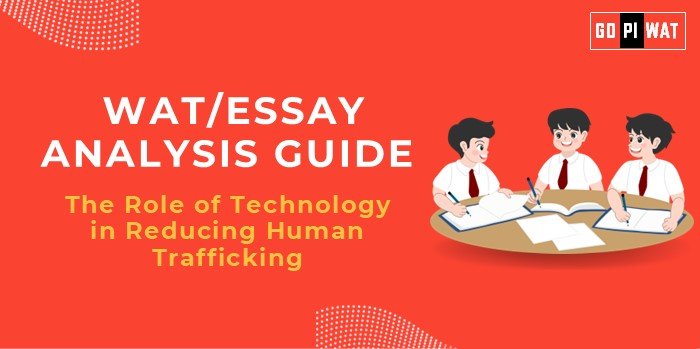📋 The Role of Technology in Reducing Human Trafficking
🌐 Understanding the Topic’s Importance
Technology has emerged as a pivotal tool in addressing systemic issues like human trafficking by offering innovative and scalable solutions. For business school students, understanding this intersection highlights the role of leadership in leveraging technology for social impact, aligning with modern governance and corporate social responsibility.
🗓️ Effective Planning and Writing
- ⏱️ Time Allocation:
- Planning: 5 minutes
- Writing: 20 minutes
- Reviewing: 5 minutes
- 📊 Preparation Tips:
- Identify key statistics and stakeholders involved in anti-trafficking efforts.
- Research real-world examples like AI tools, blockchain technologies, and mobile apps tackling trafficking.
📝 Introduction Techniques for Essays
- ⚖️ Contrast: “While traffickers exploit encrypted platforms, AI tools like Spotlight have reduced victim identification times by 65%, showcasing technology’s dual-edged role.”
- 💡 Solution-Oriented: “By integrating AI, blockchain, and community-driven apps, technology offers a lifeline to millions trapped in trafficking.”
📚 Structuring the Essay Body
- 🏆 Achievements:
- ✨ AI Tools: Technologies like Spotlight identify victims faster by analyzing vast datasets.
- 📊 Blockchain: Provides tamper-proof digital identities to reduce identity fraud and trafficking risks.
- 📱 Mobile Apps: India’s Awaaz app empowers communities to report trafficking anonymously.
- ⚠️ Challenges with Comparative Analysis:
- 🔐 Traffickers’ Misuse: Encryption and the dark web make tracking offenders difficult.
- 🌍 Global Digital Divide: Limited access to technology in rural and underdeveloped areas.
- ⚖️ Privacy Concerns: Balancing victim data protection with effective monitoring.
- 🔮 Future Outlook:
- 🤝 Global Partnerships: Foster collaborations between governments, tech companies, and NGOs.
- 📘 Ethical Tech Deployment: Design victim-centered solutions with strict data privacy policies.
📄 Concluding Effectively
- ⚖️ Balanced Perspective: “Technology has the potential to eradicate trafficking if coupled with ethical practices and global collaboration.”
- 🌍 Global Comparison: “Learning from models like Estonia’s blockchain and the US’s AI partnerships can shape future efforts globally.”
📊 Analyzing Successes and Shortcomings
Key Achievements:
- 🚀 Improved Rescue Rates: AI tools expedite victim identification and recovery.
- 🔒 Reduced Forged Identities: Blockchain technology secures personal data, preventing traffickers from exploiting identity fraud.
Ongoing Challenges:
- ⚠️ Traffickers’ Sophistication: Advanced use of encrypted channels by traffickers complicates law enforcement efforts.
- 🌍 Accessibility Gaps: Limited technological access in rural regions restricts the impact of tech solutions.
Global Context:
- 🇪🇪 Estonia: Blockchain systems reduce identity-related vulnerabilities.
- 🇺🇸 United States: AI tools like Spotlight have drastically improved victim identification rates.
🌟 Recommendations for Sustainable Progress
- 👩💻 Develop Victim-Friendly Technologies: Prioritize accessible tools with easy-to-use interfaces for vulnerable populations.
- 🔐 Strengthen Cybersecurity Frameworks: Ensure protection of victim data while countering traffickers’ digital operations.
- 📋 Foster Collaborative Efforts: Encourage cross-sector partnerships to scale impactful tech solutions globally.
📄 Sample Short Essays
- ⚖️ Balanced Perspective: “Technology has enabled significant advances in anti-trafficking efforts, such as AI tools that accelerate victim identification. Yet, ethical deployment remains vital to prevent misuse.”
- 💡 Solution-Oriented: “Blockchain and AI-driven analytics, coupled with mobile apps, have revolutionized how trafficking is tackled. Future innovations must prioritize inclusivity and ethics.”
- 🌍 Global Comparison: “Countries like Estonia showcase how blockchain reduces forgery, while US-based AI tools expedite victim rescues. Replicating these globally can ensure impactful outcomes.”


